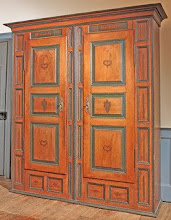Unfortunately this year, Hollie couldn't make it to New York (Andrew was accompanied by his boss, Garth's CEO Jeff Jeffers), so here is Andrew's journal of Americana Week 2009:
Wednesday:
Arrived in NY after an uneventful flight and cab ride to the hotel (in the 50s at
I also had a fabulous experience with one of the Christie’s staffers who was working the silver preview. She gave me the nickel tour of their offerings (including the
After Christie’s it was a jaunt uptown to Molly Pitcher’s where there was an informal gathering of younger Winterthur alumni, which included folks working at such institutions as the Metropolitan Museum of Art in New York, the Carnegie Museum of Art in Pittsburgh, and the Chipstone Foundation in Milwaukee (publishers of American Furniture and Ceramics in America).
After a quick bite there, we headed to The American Antiques Show. It’s a great show…quality dealers peddling quality stuff. Like Hollie and I noticed at both the
Jeff also humored me by snapping the photo of me with Giant Baby (the Giant Baby was available from Carl Hammer Gallery of Chicago).
Thursday:
Most of the day was spent at Bonham’s for their inaugural
After the Bonham’s sale, it was off to the St. Regis for drinks with business associates. Seriously folks, you need to visit this grand old hotel. You probably can’t afford a room (and maybe not even a drink…ack!), but you’ve got to see the barback. It’s a monumental painting by Maxfield Parrish. Holy smokes what a painting!
Then a late dinner with friends and then to the hotel to rest up for a busy Friday.
Friday:
Since Maine Antique Digest editor, Clayton Pennington, was in town, we got together for breakfast; and MAD writer Lita Solis-Cohen also joined us. Hollie and I have been writing the “Young Collector” column for well over a year, but this is the first time either of us had met Clayton in person. We had a wonderful chat about the column and the marketplace…and about what was to come over the next few days.
Then, Jeff and I were off to the Antiques at the Armory Show, my first time. Big variety of antiques here…from ancient to modern, but all pretty darn nice. Couldn’t spend too much time there, however, because we had to get to Christie’s for their afternoon session. Frankly, Christie’s is my favorite of the NY houses, though I realize my reasons have nothing to do with their offerings. I know more of the folks at Christie’s and I just love to sit in their auctions…John Hays is a super auctioneer; a raise of his eyebrows at you can get you to stick that  paddle up one more time.
paddle up one more time.
The auction went okay. Better than Bonham’s, but still soft prices and a number of high profile passes. A bright spot in that sale was $550,000 paid (plus the buyer’s premium) for a Charles Peale Polk portrait of George Washington by
After Christie’s, we headed to The Big Show (aka, the Winter Antiques Show). The nation’s leading dealers were there and there was some killer stuff. Sumpter Priddy, Elliot and Grace Snyder, Olde Hope, Jonathan Trace…the dealers you want to know if you want to build a great collection. Fortunately, a number of the dealers that I talked to had already “made it into profit” for the show, so there was definitely some buying.
Afterwards, we had dinner with a very good client at a great Italian place near
Saturday:
Our last day, but still a full day (evening flight). Started with the Landon collection at Sotheby’s in the morning (only 3 passed lots!) followed by a whirlwind trip to the Ceramics Fair at the National Academy Museum. One of my favorite shows even though I’m not a ceramics or glass collector (yet!). You can learn so much just by walking and looking. And if you ask questions, the dealers will go to town showing you all sorts of things. One of my favorites is glass dealer Ian Simmons, who always insists on showing me the great Midwestern glass he’s offering. When Hollie and I get a cupboard with glass doors, I told him, I’ll be calling him with my want list.
Back to Sotheby’s, then, for their afternoon multi-owner sale, and boy what a difference. In the auction world, most of us doing the selling work with consignors to allow us to use conservative estimates because we feel that lower estimates entice bidders and thus elicit more bids. This strategy was proven undeniably true in NY this week. At Bonham’s and Christie’s, and at Sotheby’s afternoon session, higher estimates (which meant higher reserves) resulted in lackluster bidding and lots of passes. However in the Landon sale at Sotheby’s (Saturday morning), the estimates were lower and there was lots of bidding. In fact, it was like a real auction (sometimes the New York auction model—that is, using aggressive reserves and hoping for just that one bidder to put his/her paddle up—seems a little artificial as auctions go).
Stay tuned to MAD for complete coverage of Americana Week in



